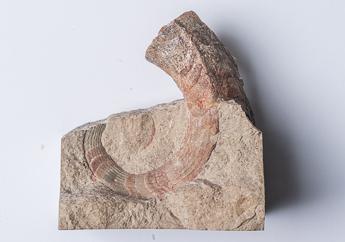Missouri Geological Survey Director: Carey Bridges, RG
Most of what is known about ancient nautiloids is from the fossilized, rigid, one-piece, external, calcium carbonate shells they left behind when they died. Every nautiloid has a shell that is shaped in a way that is diagnostic for its particular species.

Nautiloids comprise about 10 distinct groups of shelled cephalopod marine mollusks that came into existence at different times between 500 and 470 million years ago during early Paleozoic time. They quickly reached their peak taxonomic (classification) diversity and peak population density between 460 and 430 million years ago. For the remaining 200 million years of Paleozoic time, and into the first 50 million years of Mesozoic time, they suffered a general decline characterized by the gradual episodic extinction of all but one taxonomic group – Nautilida – that survived, though in ever declining numbers, for the next 200 million years to present day.
About 2,500 species of nautiloids are known to have existed through geologic time. Only two genera (subdivisions) of nautiloids containing six (some claim only three) species exist today, and they inhabit the southwestern Pacific Ocean from the Philippines to Samoa and the eastern Indian Ocean off the west coast of Australia. Only the test of time will determine whether they eventually go extinct, too.
The shell of an infant nautiloid starts out as a simple cup in which soft body parts reside. The cup constitutes the first living chamber. As the infant body grows, the length and width of the shell keeps pace through the deposition of new shell material around the rim of the cup. Periodically, a thin septum of rigid shell material is deposited behind the body and completely across the inside of the shell. Repetition of this process during growth results in a sequence of empty chambers situated behind the body chamber. In this way a growing nautiloid maintains a living chamber of proper width and depth. As each septum is added, so is a tube of shell material and soft tissue that connects every new living chamber with the tube of the previous living chamber. The individual tubes collectively form a single siphuncle (long tube) that runs the length of the shell. Since soft tissue is rarely preserved in the fossil record, most of what can be said about the soft parts of fossil nautiloids has been inferred from the nautiloids that live today. They possess two large eyes having small apertures and no lenses, numerous short cirri (tentacles), a beaked mouth that is equipped with radula (tiny ribbon of teeth) and tongue, a flexible hood that is employed for capping the living chamber in times of stress, and a hyponome that is a fleshy conduit for circulating seawater through an internal cavity that contains gills.
Nautiloids and other fossils are on display in our Ed Clark Museum of Missouri Geology. They also are found in the limestone walls of the Capitol in Jefferson City.
Nothing in this document may be used to implement any enforcement action or levy any penalty unless promulgated by rule under chapter 536 or authorized by statute.
For more information
Geological Survey Program
Missouri Geological Survey
P.O. Box 250
Rolla, MO 65402-0250
United States
